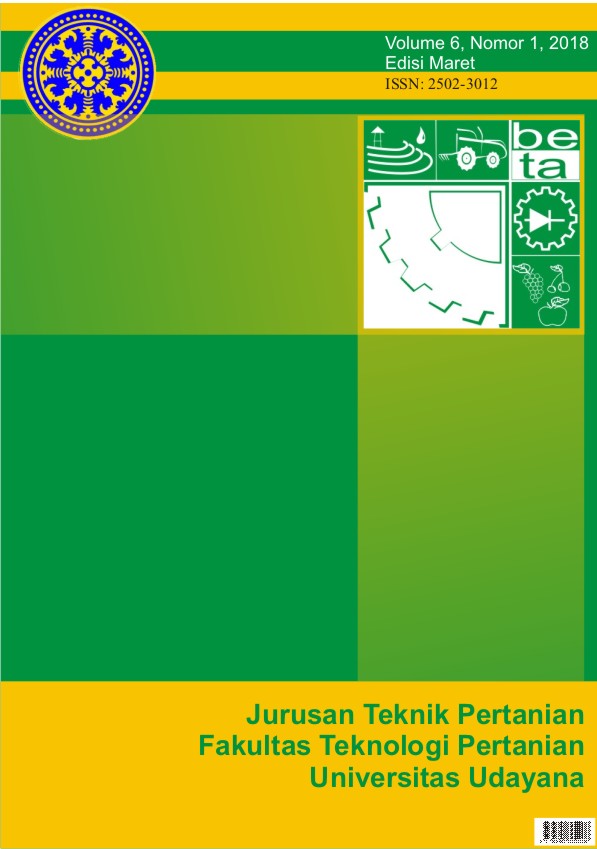Pengaruh Kadar Air Terhadap Proses Pengomposan Jerami Dicampur Kotoran Sapi
Abstract
Varietas padi unggul yang dihasilkan dapat menghasilkan jerami padi dalam satu kali panen mencapai 25 ton / ha dapat digunakan sebagai bahan baku pupuk kompos. Tujuan dari penelitian ini adalah untuk mengetahui pengaruh kadar air pada proses pengomposan jerami dan kotoran sapi, dan mengetahui kadar air yang sesuai agar proses pengomposan jerami dan kotoran sapi lebih cepat. Penelitian ini menggunakan 5 perlakuan yaitu: P1 (perlakuan kadar air 40%), P2 (perlakuan kadar air 45%), P3 (perlakuan kadar air 50%), P4 (perlakuan kadar air 55%), dan P5 (perlakuan kadar air 60%). Berat bahan untuk masing-masing perlakuan adalah 35 kg menggunakan perbandingan jerami dan kotoran sapi 3:4. Parameter yang diamati adalah suhu, kadar air, rendemen, pH, nitrogen, karbon dan rasio C/N. Suhu puncak maksimal dari 5 perlakuan adalah pada perlakuan kadar air 60% dengan suhu 49,8oC dan suhu puncak terendah adalah perlakuan kadar air 40% dengan suhu tertinggi 48,4 oC. Pengomposan awal, nilai pH berkisar 6,4-6,6 pada akhir proses pengomposan, nilai pH berkisar 6,9-7,2. Rasio C/N dari semua perlakuan memenuhi standar SNI yaitu rasio C/N berkisar 18,60-19,01. Kualitas kompos yang dihasilkan dari bahan baku jerami dan kotoran sapi pada kelima perlakuan sudah sesuai dengan standar SNI No. 19-70302004 digunakan sebagai acuan kualitas kompos.
High yielding rice varieties can be produced the rice straw in one harvest reached 25 tons/ha can be used as raw material for compost fertilizer. The purpose of this study was to determine the influence of water content in the composting process of rice straw and cow dung, and to know the appropriate water content for the process of composting the form rice waste and cow dung more quickly. This study used 5 treatments: P1 (with water content of 40%), P2 (with water content of 45%), P3 (with water content of 50%), P4 (with water content of 55%), and P5 (with water content of 60%). The material weight for each treatment was 35 kg using comparison of rice straw and cow dung 3:4. The parameters observed were temperature, water content, yield, pH, nitrogen, carbon and C/N ratio. The maximum peak temperature of the 5 treatments is at 60% water content with temperature of 49.8oC and the lowest peak temperature is a 40% water content with a highest temperature of 48.4oC. Early composting, pH values ranged from 6,4-6,6 and at the end of the composting process, pH values ranged from 6,9-7,2. The C/N ratio of all treatments meets the SNI standard ie the C/N ratio ranged from 18,60-19,01. The quality of compost that been produced from the raw materials of straw and cow dung on the five treatments was in accordance with the SNI standard no. 19-70302004 is used as a reference of compost quality.
Downloads
References
Atmaja, K., Tika, W., Anom, S. (2016). Pengaruh Perbandingan Komposisi Jerami dan Kotoran Ayam Terhadap Kualitas Pupuk Kompos. Jurnal Beta (Biosistem dan Teknik Pertanian). Volume 5, Nomor 1, Januari, 2017 http://ojs.unud.ac.id/index.php/beta
Djuarnani, N., et al. (2005). Cara Cepat Membuat Kompos. AgroMedia Pustaka. Jakarta.
Djuarnani, N., Kristiani, dan B, S. Setiawan. (2008). Cara Cepat Membuat Kompos. Penerbit PT. Agromedia Pustaka. Jakarta.
Graves, R., Hattemer, G.M., Stetter, D., Krider, J.N. dan Dana, C. (2000). National Engineering Handbook. United States Departement of Agriculture.
Harada, YK, Haga, Tosada, and Kashino M. (1993). Quality of produced from animal waste. JARQ 26:238-246.
Indriani, Novita Hety. (2011). Membuat Kompos Secara Kilat. Penebar Swadaya. Jakarta.
Isroi. (2008). Kompos. Balai Penelitian Bioteknologi Perkebunan Indonesia, Bogor.http://id.wikipedia.org/wiki/kompos diakses tanggal 15 April 2017
Kurnia, Anggraini Dwi., at al. (2009). “Aromterapi Bunga Lavender Memperbaiki Kualitas Tidur pada Lansia”. Jurnal Kedokteran Brawijaya. Program Studi Ilmu Keperawatan Fakultas Kedokteran Universitas Brawijaya. Malang.
Kusuma, M. A. (2012). Pengaruh Variasi Kadar Air terhadap Laju Dekomposisi Kompos Sampah Organik di Kota Depok (Doctoral dissertation, Tesis Fak. Teknik Program Studi Teknik Lingkungan Universitas Indonesia).
Massa, S., Setiyo, Y., Widia, W. (2016). Pengaruh Perbandingan Jerami dan Kotoran Sapi Terhadap Profil Suhu dan Karakteristik Pupuk Kompos yang Dihasilkan. Jurnal Beta (Biosistem dan Teknik Pertanian) Volume IV, Nomor 2, September, 2016 http://ojs.unud.ac.id/index.php/beta
Madrini, I. A. G. B. (2016). Community-based Composting and Management of Leftover Food for Urban Agriculture. Thesis. Agricultural and Environmental Engineering, United Graduate School of Agricultural Science, Tokyo University of Agriculture and Technology.
Murbandono, L. (2008). Membuat Kompos. Penebar Swadaya, Jakarta.
Ponnamperuma, F. N. (1984). Straw as a Source of Nutrientfor Wtland Rice. In Organic Matter and Rice, P. 117 –136. International Rice Research Institute, Los Banos, Phillipines.
Setiyo, Y., W, Arnata, NL Yuliarti, dan G. Arda. (2012). IBM Simantri Kelompok Tani Sari Bumi.
Setiyo, Y., Hadi K.P., Subroto, M.A, dan Yuwono, A.S. (2007). Pengembangan Model Simulasi Proses Pengomposan Sampah Organik Perkotaan. Journal Forum Pascasarjana Vol 30 (1) Bogor.
Supadma, A. A. N., dan Athagama, D. M. (2008). Uji Formulasi Kualitas Pupuk Kompos Yang Bersumber Dari Sampah Organik Dengan Penambahan Limbah Ternak Ayam, Sapi, Babi dan Tanaman Pahitan. Jurnal Bumi Lestari Vol. 8 (2): 113-121.
Sutedjo, M. (2002). Pupuk dan Cara Pemupukan. Rineka Cipta. Jakarta.
Yulipriyanto. (2010). Biologi Tanah dan Strategi Pengelolaannya. Graha Ilmu: Yogyakarta












 Jurnal BETA (Biosistem dan Teknik Pertanian)
Jurnal BETA (Biosistem dan Teknik Pertanian)


